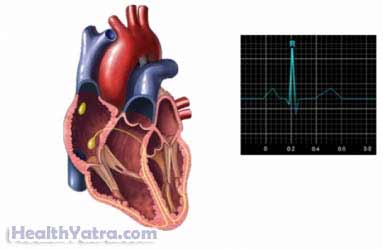Definition
A premature ventricular beat (PVB) is an extra heartbeat caused by abnormal electrical activity. It starts in the ventricles (the lower chambers of the heart) before a normal heartbeat occurs. PVB interferes with the heart’s normal rhythm and causes a pause before the next heartbeat. It may feel like a heartbeat is skipped.
PVBs are common, especially among the elderly. They can occur in people who are healthy, in which case they are harmless. However, when they occur after a heart attack or heart surgery they can lead to dangerous heart rhythms. In some cases, these rhythms can cause sudden death. You should contact your doctor right away if you suspect you have PVBs after a heart attack or heart surgery.

Causes
The causes of PVBs include:
- Physical or emotional stress
- Physical exercise
- Caffeine, alcohol, tobacco, and other drugs (eg, cocaine, amphetamines)
- Certain medications, especially those that stimulate the heart
- Heart disease:
- Heart attack
- Coronary artery disease
- Disorders that cause the ventricles to get larger (eg, heart failure)
- Heart valve disorders
- Congenital heart disease
Risk Factors
A risk factor is something that increases your chance of getting a disease or condition.
The following factors increase your chance of developing PVBs:
- Age: frequency increases with age, PVBs are most common in the elderly
- Sex: more common in men than women
- Race: African Americans have a much higher risk than Caucasian
- Heart disease
- Use of caffeine, alcohol, tobacco, or other drugs
Symptoms
In many cases, there are no symptoms. When symptoms do occur they can include:
- Feeling the heart beating (palpitations)
- Feeling of a skipped or missed heart beat
In people with heart disease, PVBs can cause decreased blood flow from the heart to other parts of the body. This can produce dizziness and fainting.
Diagnosis
Your doctor will ask about your symptoms and medical history, and perform a physical exam. If you have heart disease, you should see a cardiologist.
Tests may include:
- Lab Tests
- Electrolyte levels, especially potassium and magnesium
- For medication levels in people taking medication that may affect heart rhythms
- Electrocardiogram (ECG) —shows the electrical activity of the heart rhythm and rate.
- Ambulatory or holter monitoring —continuous cardiac monitoring. This may be used if you have symptoms but heart rhythm disturbance does not show up on an ECG. This type of monitoring is helpful because it measures heart activity over a longer period of time.
- Echocardiogram —shows an image and function of heart structures using ultrasound (high-frequency sound waves).
Treatment
In most cases, no treatment is needed. However, it can be helpful to reduce stress and avoid caffeine, alcohol, and tobacco. If a medication you are taking may be causing the PVBs, talk with your doctor about whether you should reduce the dose or change medications.
You may need to take medication if you have significant symptoms from PVBs, have heart disease, or if the pattern of the PVBs indicates a risk of developing more serious heart rhythm problems. Beta-blockers are generally tried first since they are relatively safe medications. Antiarrhythmic drugs may be used, but they may also increase the chances of developing dangerous heart rhythms. Other medications that may be used include calcium channel blockers. Talk with your doctor about the best treatment for you.
Prevention
To help reduce your chances of having PVBs:
- If you smoke, quit
- If you consume caffeine and/or alcohol, do so in moderation
